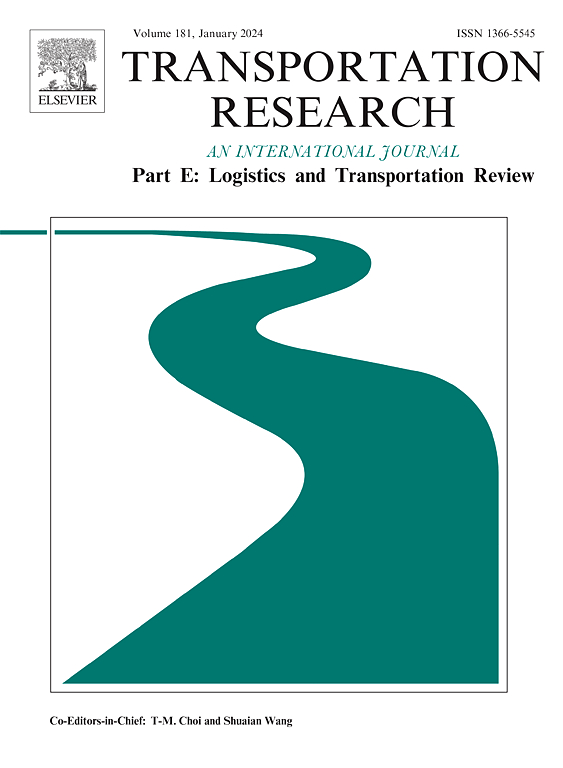Combined China-Europe Railway Express and maritime transport with subsidy and emission tax considerations
IF 8.8
1区 工程技术
Q1 ECONOMICS
Transportation Research Part E-Logistics and Transportation Review
Pub Date : 2025-09-25
DOI:10.1016/j.tre.2025.104421
引用次数: 0
Abstract
This paper investigates the effects of the combined China-Europe Railway Express (CERE) and maritime transport on the China-Europe cargo transport market with subsidy and emission tax considerations. The interrelationships among shippers, railway carrier, domestic liner carrier, foreign liner carrier and the social planner are described by a vertical structure model. Four types of carrier operating regimes, namely full competition, full cooperation, and the cooperation between railway carrier and domestic or foreign liner carrier, are explored and compared. The aim of the social planner is to achieve the welfare maximization of the system by optimizing the subsidies for the railway carrier and the emission taxes on the domestic and foreign liner carriers for creating a mankind community from a perspective of the shared future. The emission amounts before and after implementing the policies of the subsidies and the emission taxes are compared. The results show that: (i) the cooperation of the railway carrier and the domestic (or foreign) liner carrier reduces (or raises) the emission tax on the domestic (or foreign) liner carrier, but raises (or reduces) the subsidy for the railway carrier; (ii) the social planner tends to impose the emission tax on the domestic liner carrier for a low congestion level at the transfer port and a high substitution degree between combined CERE-maritime transport and direct waterway transport; the planner is inclined to subsidize the foreign liner carrier and the railway carrier for a low congestion level and a low substitution degree to encourage more shippers to use the low-carbon mode of the combined CERE-maritime transport; and (iii) the subsidy and emission tax policies are beneficial to emission reduction for a low congestion level and a high substitution degree. These findings provide a guidance for the Chinese and European governments to promote the development of the combined CERE-maritime transport mode and to control the carbon emissions of the China-Europe cargo transport market through adjusting the subsidy and emission tax policies.
中欧班列和海运联运,并考虑补贴和排放税
本文从补贴和排放税两个方面考察了中欧班列与海运联运对中欧货物运输市场的影响。托运人、铁路承运人、国内班轮承运人、国外班轮承运人和社会规划者之间的相互关系用垂直结构模型来描述。探讨并比较了铁路承运人与国内外班轮承运人之间的充分竞争、充分合作以及铁路承运人与国内外班轮承运人的合作四种承运人经营模式。社会规划者的目标是从人类命运共同体的角度出发,通过优化铁路承运人的补贴和国内外班轮承运人的排放税,实现系统的福利最大化。比较了补贴政策和排放税政策实施前后的排放总量。结果表明:(1)铁路承运人与国内(或国外)班轮承运人的合作降低(或提高)了国内(或国外)班轮承运人的排放税,但提高(或减少)了对铁路承运人的补贴;(2)社会规划者倾向于对中转港拥堵程度较低、海运联运与水运直接替代程度较高的国内班轮承运人征收排放税;规划者倾向于对拥堵程度低、替代程度低的外轮承运人和铁路承运人给予补贴,鼓励更多的托运人采用中欧海运联运的低碳模式;(3)在低拥堵水平和高替代度的情况下,补贴和排放税政策有利于减排。研究结果可为中欧政府通过调整补贴和排放税政策,促进中欧海运联运模式的发展,控制中欧货物运输市场的碳排放提供指导。
本文章由计算机程序翻译,如有差异,请以英文原文为准。
求助全文
约1分钟内获得全文
求助全文
来源期刊
CiteScore
16.20
自引率
16.00%
发文量
285
审稿时长
62 days
期刊介绍:
Transportation Research Part E: Logistics and Transportation Review is a reputable journal that publishes high-quality articles covering a wide range of topics in the field of logistics and transportation research. The journal welcomes submissions on various subjects, including transport economics, transport infrastructure and investment appraisal, evaluation of public policies related to transportation, empirical and analytical studies of logistics management practices and performance, logistics and operations models, and logistics and supply chain management.
Part E aims to provide informative and well-researched articles that contribute to the understanding and advancement of the field. The content of the journal is complementary to other prestigious journals in transportation research, such as Transportation Research Part A: Policy and Practice, Part B: Methodological, Part C: Emerging Technologies, Part D: Transport and Environment, and Part F: Traffic Psychology and Behaviour. Together, these journals form a comprehensive and cohesive reference for current research in transportation science.

 求助内容:
求助内容: 应助结果提醒方式:
应助结果提醒方式:


